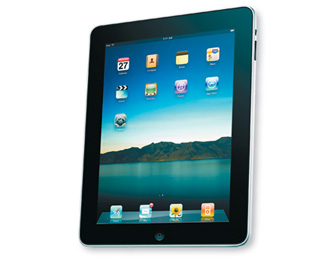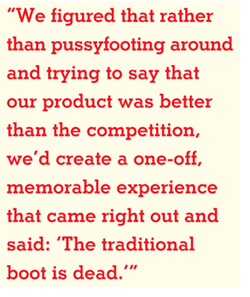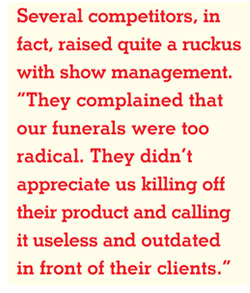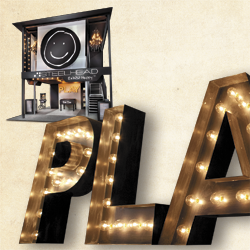 |
Infused with product messages, PayLock LLC's tongue-in-cheek, funeral-inspired exhibit program incorporated myriad tactics to keep
the laughs coming.

An obituary for the traditional boot ran in the show directory, which was available starting the day before the show opened.
Two memory boards displaying images of the traditional boot and the paper permit paid homage to the Smart-Boot's "deceased" competitors. For example, one image portrayed the boot in a graduation cap and gown.

Following the show's ribbon-cutting ceremony, PayLock pallbearers hoisted the coffins onto their shoulders and led a processional to PayLock's booth.

The two coffins were positioned near the back of the exhibit. Monitors above the coffins displayed the time of the next funeral presentation along with whimsical images during the eulogies.

A five-piece jazz band accompanied the processional, recreating a New Orleans-style funeral march.

The booth featured full funeral-parlor regalia, such as these faux Roman columns supporting a branded sign at the entry point.

Tissue boxes, black carpet, and casket sprays adorned the surreal 16-seat in-booth funeral parlor.

PayLock staffers read the eulogy, which explained the traditional boot's fate through excerpts from the traditional boot's journal.

Attendees that read pre-scripted eulogies of their own were entered into a drawing for an iPad.

After the funeral, the bereaved filed past the caskets to pay their respects and collect their free T-shirts.
|
 |
 It's not unusual for exhibitors to go to shows hoping to metaphorically "bury the competition." Especially in this economy, many companies have adopted a sort of "kill, or be killed" mentality as they try to elevate their products and services over those of their competitors. It's not unusual for exhibitors to go to shows hoping to metaphorically "bury the competition." Especially in this economy, many companies have adopted a sort of "kill, or be killed" mentality as they try to elevate their products and services over those of their competitors.
But a murderous mob of sorts at PayLock LLC, a manufacturer of a self-release car-booting system called the SmartBoot, took this hit-man mentality one step further. Rather than just making a symbolic killing at the 2010 International Parking Institute Conference & Expo (IPI) in Las Vegas, the Somerville, NJ-based company buried competing products with a funeral-based booth theme. Including everything from in-booth caskets to after-hours wakes, PayLock's morose strategy used dead-pan humor to rub out the competition - and slay its own expectations in the process.
Death by Innovation
What some might call PayLock's absurd, albeit effective, strategy can be traced to the company's 2004 launch. In fact, PayLock's president, Cory Marchasin, hoped to snuff out traditional car boots almost from the very beginning.
"My partners and I acquired a car-boot company in 2004, but rather than continue with this traditional technology, we looked for ways to develop a competitive edge and differentiate ourselves from the competition," Marchasin says. "As part of our creative process to build a better boot, we decided it wasn't actually the product that needed refining so much as it was the business process itself. Traditional boots and the process associated with them just didn't seem to make sense anymore."
That's because the traditional car-booting system isn't only maddening for car owners; it's typically a pain in the fanny for the municipalities that use it. Take the city of Wilmington, DE, for example, which, prior to installing PayLock's SmartBoot system, was owed more than $23 million in delinquent parking fines.
To collect that revenue, Wilmington had been using a traditional car-booting system, whereby boot crews located vehicles whose owners had amassed a significant amount of fines, and applied unwieldy traditional boots to the wheels, effectively making the vehicles inoperable. When car owners returned and found boots on their cars, they had to first get a ride to the city's parking/finance department to pay their fines. Then, after spending hours in line to pay the fines, they had to catch a ride back to their cars and wait for the boot crews to free up their vehicles.
The traditional boot system is tedious for motorists, who spend an average of five hours engaged in the teeth-grinding process. But it's also a nightmare for the municipalities doing the booting. Boot crews waste hours trying to locate and boot the cars (comparing printed lists of offenders to the license plates of parked cars), and after the fines are paid, they have to return to the cars to un-boot them. For some cities, the costs of booting and un-booting automobiles can rival the revenue of the paid fines.
In the case of Wilmington, its boot crews simply couldn't keep up with the workload. At one point there were more than 50,000 vehicles on the city's boot-eligibility list - and the numbers were still growing, pushing the boot crews farther and farther behind.
But thanks to PayLock, which revolutionized the booting process by inventing the SmartBoot technology, many of the system's speed bumps and pain points have been eliminated. First off, instead of using printed lists and boot-crew members' eyeballs to identify the vehicles of delinquent drivers, the municipality uses a vehicle equipped with mobile, license-plate recognition technology (MLPR). As a city employee drives the vehicle up and down streets, the MLPR automatically scans license plates and checks them against a parking-ticket database, sounding an audible alarm when a bootable vehicle is found.
Additionally, when motorists discover SmartBoots on their cars, they simply follow the instructions on the notice
attached to the car and call PayLock's 24/7 help center to provide payment info. Usually within less than five minutes, the motorist's payment is processed, and the help center provides him or her with a code, that when punched into the keypad on the SmartBoot, unlocks it from the vehicle.
The motorist then returns the boot to a predetermined drop-off location in the city within 24 hours. (Failure to return the boot within the specified time racks up an additional
charge, which is collected via the payment method previously provided by the motorist.) That means the motorist doesn't have to drive to the parking-authority office, can call PayLock's help center at any time of day, and has 24 hours to return the boot to a drop-off location. But more importantly for city officials, only in rare circumstances (such as when the motorist is unable to lift the 16-pound device) do boot crews ever have to
return to a vehicle to remove a boot.
In Wilmington's case, use of the SmartBoot increased boot-related revenue by more than 550 percent, compared to traditional boot technology. So for many cities the SmartBoot is becoming the boot of choice. Thus, in effect, PayLock's invention not only changed the car-booting system; it killed the traditional car boot in the process. (May it rest in peace.)
A Salesperson's Lament
Despite its seemingly undisputable logic and unarguable improvements over traditional booting, SmartBoots are not an easy sell. Not only is the product relatively new (which makes city and state officials somewhat wary), but also the company's prime targets have a tough row to hoe when it comes to changing the status quo.
"Even if we successfully get our targets to buy in to our technology, when they go back to their city councils and encourage them to buy our system, it usually takes between six months to two years to move the city's decision makers to the point of a sale," Marchasin says. "Generally speaking, city leaders are resistant to systemic change, and they're certainly not quick to implement anything like this that completely changes the game. And even when a city is inches away from a contract, economic and political changes within the city can drag us right back to square one again."
What's more, there are only so many city and state officials in need of booting systems. After all, you probably don't need a major booting program in Podunk USA. "In reality, we only have a few hundred potential clients we're going after," says Chad Collins, PayLock's vice president. "And each one of them needs a very specific, custom solution. So when it comes to our exhibit-marketing program, we're well aware that nobody is going to march into our booth, watch our presentation, and sign a contract on the spot." Thus, PayLock's booth strategy typically involves educating attendees
about its offerings with a general as opposed to city-specific solution - and
reminding them year after year that whenever they're ready, PayLock has a custom solution for them. "Because finally, when the planets align and the time is right politically and economically for their city," Collins says, "they'll eventually call us to make the sale."
PayLock's trade show strategy, then, revolves around educating customers about the SmartBoot technology, demonstrating that the company can create solutions for each city's needs, and creating a memorable experience that
will stick with them over the long haul. Certainly, PayLock also wants to generate leads and make sales. But given its customers' unique purchasing situations, a memorable experience that's linked to the company and its products is paramount. That way, whenever it comes time to make a purchase, the PayLock name is already in prospects' memory banks, ready for withdrawal.
For IPI, a show drawing hundreds of PayLock's prime targets, the company had always done something a little bit different. "We've used everything from a booted Lotus in the middle of the exhibit to a massive distribution of T-shirts with parking-related slogans to distinguish us as a creative company with something different to offer," Collins says.
"In 2010, we decided to continue this 'different' approach by creating a spectacle the likes of which these parking
professionals had never seen," Marchasin says. "We figured that rather than pussyfooting around and trying to say that our product was better than the competition, we'd create a one-off, memorable experience that came right out and said: 'The traditional boot is dead.' And to relay that message, we thought a funeral-themed booth in which we actually laid competitors' products to rest was the perfect delivery method."
Of course, when you dip that somewhat disturbing delivery into a vat of humor and wrap it with all the trappings of a tongue-in-cheek funeral, you've got an integrated program that's anything but stiff.
Dawn of the Death March
PayLock's program launched shortly before the 2010 show when the company "leaked" news of its plans to John Van Horn, publisher of and blogger for Parking Today, an industry publication with a significant online following. "About a month before the show, we sent John a few tidbits about what we planned to do, knowing that he'd blog about it to pique attendees' interest," Marchasin says. "He mentioned us in the blog several times. For example, he wrote something like, 'I don't know what PayLock's up to at IPI this year, but you may want to stop by their booth to pay your respects to a fallen old industry friend.'"
PayLock also placed an obituary for the boot in the show directory. Personifying the traditional boot - a tactic continued throughout the rest of the program - the obit led with the heading "Traditional Boot dies at 66." It went on to read: "Boot, age 66, of Denver, Colorado died of natural causes on Friday, May 7, 2010. In addition to his parents, Manual Meter and Paper Ticket, the Boot was predeceased by his brother, Honor Box. He is survived by his children, Digital Permit and SmartBoot." The obituary also explained that the Boot was overweight for most of his life, yet he tightly clamped down on vehicles and required teams of people to be properly applied and removed.
Curiosity piqued by the obituary and blog posts, attendees flocked to the show to discover what PayLock had up its sleeve. But before they could even enter the exhibit hall, they were taken aback by the unexpected presence of two coffins just outside the main entrance.
"We created two coffins painted gray, and displayed them on stands just outside the exhibit hall's entrance," Collins says. One held a traditional boot, and the other held a paper parking permit "dressed" in a mini tuxedo. (While PayLock's program focused almost exclusively on the death of the traditional boot, the company also paid its respects to paper parking permits. Killed off by its digital permit-management system, the permit's demise was a secondary aspect of the program, mentioned during in-booth presentations and in a photo mural at the booth's entrance.)
Immediately after the show's ribbon-cutting ceremony, PayLock pallbearers, i.e., sunglass-wearing exhibit staffers dressed in all black except for their corporate orange or green Vans shoes, hoisted the coffins onto their shoulders.
A five-piece jazz band similar to those used for New Orleans "jazz funerals" joined the group and led a procession (pre-approved by show manage-ment) into the exhibit hall. Attracting attention like gawkers to a car wreck, the growing group of mourners joined the death march through the hall - with the band playing a dirge to complete the effect - eventually ending at PayLock's 20-by-30-foot island booth. As pallbearers positioned and opened the coffins atop display pedestals, onlookers took in their surroundings.
Decked out in full funeral-parlor regalia, which was designed and produced by PayLock staff, the exhibit space featured the two coffins - each of which now bore demure casket sprays made of white roses. A pedestal above each casket held a monitor bearing an image of a boot and the words, "Traditional Boot, 1944 - 2010. Final Viewing 2:15. Free T-shirts." Sixteen chairs, tastefully draped in black fabric, formed a viewing area in front of the caskets, while an aisle ran down the center of the space, allowing the bereaved easy access to the coffins, where they could view the deceased and pay their respects.
Black carpet and tissue boxes scattered throughout continued the surreal scene, and an enlarged copy of the obituary that ran in the show directory was posted near the front entrance to the space. Here, two faux Roman columns supported a header bearing the PayLock logo, and two poster boards resting on easels offered a pictorial history of the Boot's life and that of the Paper Permit. For example, Photoshop-created images depicted the Boot playing in his first little-league game, graduating from high school in his cap and gown, and eating his first bite of wedding cake with his wife (another traditional boot with a limited future).
Show "Services"
This clever processional wasn't the end of PayLock's morbid scene. Shortly after the precession reached the booth space, PayLock held the first of what would be a total of six funerals, i.e., presentations, throughout the show. Staffers quickly invited onlookers to take a seat and help lay to rest the traditional boot. With the chairs filled and onlookers clogging the aisles, Marchasin opened the funeral with a brief - but emotional - explanation.
"Welcome, and thank you for coming to pay your respects to the traditional boot," Marchasin began, appearing as if he might choke up at any moment. But then he broke character saying, "OK, folks, here's what we're gonna do. As you can probably guess, the traditional boot is dead. His attorney gave us his journal, from which we're gonna read you some passages to see how and why he passed." Then Marchasin explained that attendees would have an opportunity to come forward and give their own eulogies to the Boot in exchange for entry into a drawing to win an iPad, which the paper permit pre-ordered before his demise. Furthermore, Marchasin informed attendees that if they stayed through the entire 25-minute service, they would all receive parking-themed T-shirts that were allegedly bequeathed to PayLock by the fallen boot.
 Marchasin then held up shirt samples, which were also scattered throughout the booth, that featured death-themed messages and parking-related humor. A black shirt, for example, featured a SmartBoot covered with a black cloak and holding a sickle in its bony, gloved hand. The implied message, of course, was that the SmartBoot was the Grim Reaper who'd brought death to the traditional boot. A different design comprised a white shirt with a graphic that resembled a Hooters logo complete with the bug-eyed owl. But rather than "Hooters," the T-shirt read "Booters" instead. Marchasin then held up shirt samples, which were also scattered throughout the booth, that featured death-themed messages and parking-related humor. A black shirt, for example, featured a SmartBoot covered with a black cloak and holding a sickle in its bony, gloved hand. The implied message, of course, was that the SmartBoot was the Grim Reaper who'd brought death to the traditional boot. A different design comprised a white shirt with a graphic that resembled a Hooters logo complete with the bug-eyed owl. But rather than "Hooters," the T-shirt read "Booters" instead.
"While the funerals in and of themselves would likely draw attendees to our space, we turned to an old-reliable strategy - free T-shirts - to lure even more attendees to our booth," Collins says. "And we made sure that people knew they'd only get the coveted shirts if they stayed in their seats until the end."
So after explaining the funeral itinerary, Marchasin dropped back into character and began reading passages from the boot's journal, dated May 14, 2008. "I was out with my parking-enforcement officer today, and I overheard him talking about a SmartBoot demo," he read. "They wouldn't say it to my face ... but they were talking about how light it was and how easy it was to put on. Truly, I know I'm a fat ass, but it's not my fault; I'm just big boned." As he read, images related to the journal entries - such as pictures of the boot's parking-enforcement officer, Morty - appeared on the monitors mounted over the caskets.
Another entry dated approximately a month later revealed that the boot felt lonely and ignored, as he'd been left out all night on a car in a bad neighborhood. The motorist had discovered him before dark, but since the motor-vehicle office was closed, he'd been stuck there until the motorist could pay his fine the next morning.
In the final journal entry, the boot discovered that he had been decommissioned. He found himself in a dark storage area of the parking-enforcement office. As someone flicked on the lights, he suddenly realized that he was surrounded by bright, shiny new SmartBoots, and he knew the end had come: He'd never be used again.
"While the whole presentation is all about the humor - which is what makes it so memorable - it's tactfully scattered with product messages," Marchasin says. "People learn not only why the traditional boot is dead, but why our SmartBoot is the next best thing. There's also a journal entry or two about our digital permit system and the death of the paper permit. At the end of the journal reading, we left the boot's demise as sort of a mystery. Attendees weren't sure if the boot was scrapped by the parking-enforcement officers, or if, as a result of knowing his future would be spent in a storage closet, he took his own life."
After establishing the mysterious fate of the traditional boot, Marchasin gave attendees the opportunity to offer their own eulogies (which he had carefully scripted), and enter their name into the iPad drawing held at the end of the trade show. One at a time, attendees eagerly stepped forward to read their eulogies, which were humorous or product-related messages typed on small sheets of paper.
 One sheet, for example, offered a joke: "Why did the SmartBoot kill the old boot? Because the old boot pressed all its buttons." Another sheet read, "Parking parking, bo farking, banana fanna fo farking, mi, my mo marking, parking." Especially on the relatively conservative IPI show floor, the spectacle created by attendees standing in front of their peers and reading ridiculous jokes and tongue twisters heightened the humor factor, making PayLock's in-booth funeral the life of the IPI party. One sheet, for example, offered a joke: "Why did the SmartBoot kill the old boot? Because the old boot pressed all its buttons." Another sheet read, "Parking parking, bo farking, banana fanna fo farking, mi, my mo marking, parking." Especially on the relatively conservative IPI show floor, the spectacle created by attendees standing in front of their peers and reading ridiculous jokes and tongue twisters heightened the humor factor, making PayLock's in-booth funeral the life of the IPI party.
Finally, after the last eulogy, Marchasin told mourners to line up along either side of the central aisle and slowly file past the coffins to pay their respects to the deceased - and to collect their T-shirts in passing. He also invited attendees to an Irish wake PayLock would host in a suite in The Hotel at Mandalay Bay. Here, PayLock served drinks and finger foods for roughly an hour after the show closed each day - giving staffers more time to talk shop with the bereaved.
Life (and Leads) After Death
All told, funeral attendees remained in the booth for a whopping 25 to 35 minutes, each one of which was spent not only soaking up the message that the traditional boot is dead, but also experiencing a one-off spectacle only the feeble minded would soon forget.
"We didn't beat people over the head with our messages," Collins says. "Because once they understand our technology and the benefits it offers them, our main goal is to burn our experience into their memories so they'll recall our name months or even years down the road. According to not only our own staff but also some of our competitors, we accomplished our goals and then some."
Several competitors, in fact, raised quite a ruckus with show management. "They complained that our funerals were too radical," Collins says. "They didn't appreciate us killing off their product and calling it useless and outdated in front of their clients. But we figured that if we hadn't gotten any complaints, that would have meant our spectacle wasn't big enough."
In terms of more concrete numbers, however, PayLock knows that 500 attendees watched its funeral presentation. That's because it handed out 500 T-shirts, and in order to obtain one, attendees had to sit (or stand) through one of the 25-minute funerals. "Given the amount of time we spent with attendees and the amount of information they heard, 500 is a huge success for us." Plus, 25 to 35 people attended the private wakes each day, giving PayLock extra time with key attendees, and inching them ever closer to a sale.
But far more importantly, PayLock walked away with 10 highly qualified leads, which it defines as hot prospects with near-future buying intent and appropriate city sizes and budgets. "We actually took home 10 qualified leads, which is the most we've ever gotten at a show," Marchasin says. "Our closure rate is usually 25 percent on these kinds of leads, so that's two or three contracts. And whenever these two or three contracts come to fruition, it'll give us a return of several thousand percent of our show investment." With results like that, PayLock made a killing in more ways than one. E
|














 It's not unusual for exhibitors to go to shows hoping to metaphorically "bury the competition." Especially in this economy, many companies have adopted a sort of "kill, or be killed" mentality as they try to elevate their products and services over those of their competitors.
It's not unusual for exhibitors to go to shows hoping to metaphorically "bury the competition." Especially in this economy, many companies have adopted a sort of "kill, or be killed" mentality as they try to elevate their products and services over those of their competitors.  Marchasin then held up shirt samples, which were also scattered throughout the booth, that featured death-themed messages and parking-related humor. A black shirt, for example, featured a SmartBoot covered with a black cloak and holding a sickle in its bony, gloved hand. The implied message, of course, was that the SmartBoot was the Grim Reaper who'd brought death to the traditional boot. A different design comprised a white shirt with a graphic that resembled a Hooters logo complete with the bug-eyed owl. But rather than "Hooters," the T-shirt read "Booters" instead.
Marchasin then held up shirt samples, which were also scattered throughout the booth, that featured death-themed messages and parking-related humor. A black shirt, for example, featured a SmartBoot covered with a black cloak and holding a sickle in its bony, gloved hand. The implied message, of course, was that the SmartBoot was the Grim Reaper who'd brought death to the traditional boot. A different design comprised a white shirt with a graphic that resembled a Hooters logo complete with the bug-eyed owl. But rather than "Hooters," the T-shirt read "Booters" instead.  One sheet, for example, offered a joke: "Why did the SmartBoot kill the old boot? Because the old boot pressed all its buttons." Another sheet read, "Parking parking, bo farking, banana fanna fo farking, mi, my mo marking, parking." Especially on the relatively conservative IPI show floor, the spectacle created by attendees standing in front of their peers and reading ridiculous jokes and tongue twisters heightened the humor factor, making PayLock's in-booth funeral the life of the IPI party.
One sheet, for example, offered a joke: "Why did the SmartBoot kill the old boot? Because the old boot pressed all its buttons." Another sheet read, "Parking parking, bo farking, banana fanna fo farking, mi, my mo marking, parking." Especially on the relatively conservative IPI show floor, the spectacle created by attendees standing in front of their peers and reading ridiculous jokes and tongue twisters heightened the humor factor, making PayLock's in-booth funeral the life of the IPI party.


